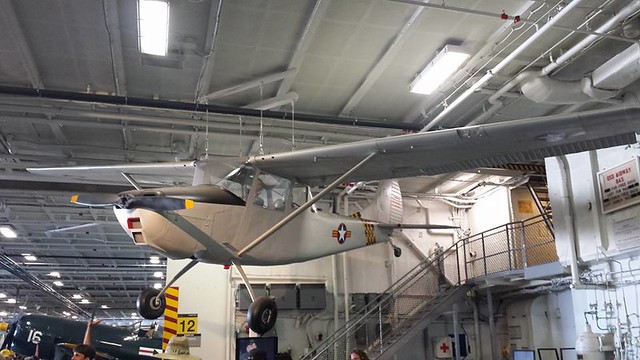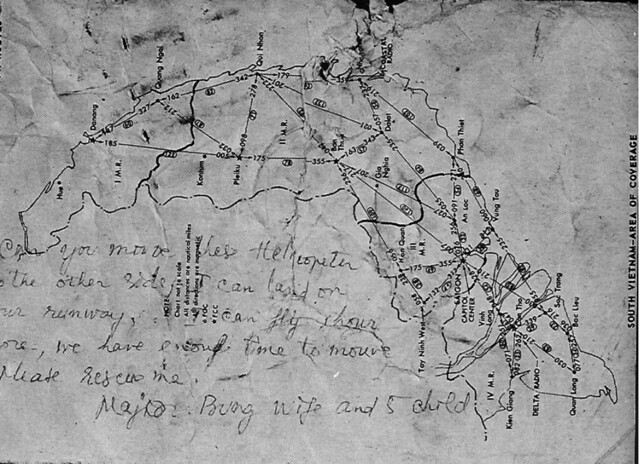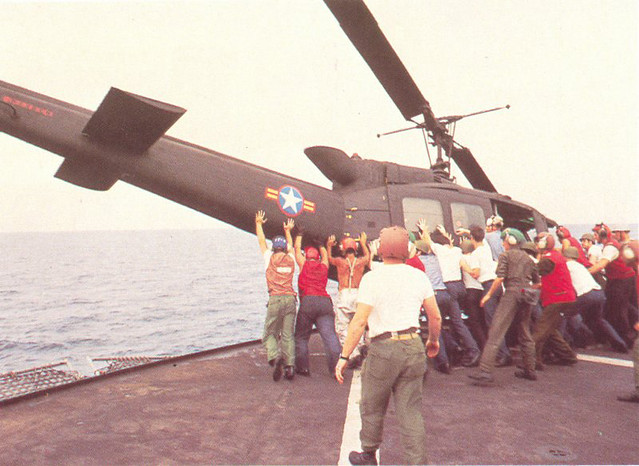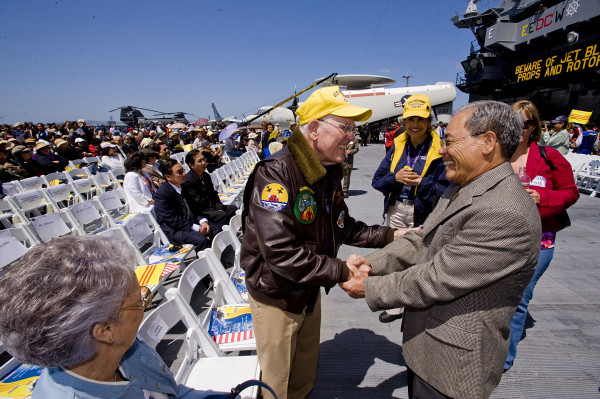One of the volunteers I work with at the Pima Air & Space Museum is a young University of Arizona aeronautical engineering student. His family is originally Vietnamese and I have the impression his father or maybe grandfather immigrated to the USA after the communist takeover. I’m sure there’s a fascinating story behind that, and I’ll have to ask him about it some day.
Earlier today he posted a photo of a famous airplane to Facebook, along with the story of how that airplane came to be on the USS Midway, the former US Navy carrier that is now a floating museum in San Diego. With his permission, I’m cross-posting the story here.

I remember the chaos of the last days of the American presence in South Vietnam, and reading about this and similar dangerous, hair’s-breadth rescues. I vividly remember TV news footage of helicopters being pushed over the side of an aircraft carrier. It turns out that memory is part of this story. Rather than reconstruct the story myself, I’ll quote Loc Ho’s Facebook post:
Visited the USS Midway yesterday and was surprised to see this aircraft. From the 29th to the 30th of April, 1975, the US military (I believe it was predominantly the Navy and Marines), seeing the approach of communist soldiers to the South Vietnamese capital of Sài Gòn, launched Operation Frequent Wind to evacuate any South Vietnamese nationals that worked with the US and would be in danger of political prosecution. The US military evacuated large numbers of people by airlift, the Vietnamese military helped, and many people attempted to evacuate themselves too. The Vietnamese Air Force (VNAF) flew themselves, their family members, and others out to safety.
Among the VNAF aircraft to fly out that day was this O-1 Bird Dog. This aircraft somehow found its way out to the ocean and to the USS Midway, an aircraft carrier. The Midway considered having the aircraft ditch in the ocean and have US helicopters fish them out. The crew members soon saw that the aircraft had at least four people onboard and that ditching was unfeasible. After circling around a few times, the pilot dropped a note onto the ship, revealing that the aircraft had him, his wife, and their five children on board and requesting that the Midway move a few of their helicopters aside to make room for him to land. The crew of the Midway quickly went into action and shoved $10 million worth of helicopters overboard.
With the deck clear for him to land, the pilot came in and touched his craft onto the deck, bounced once, and then rolled to a stop, with space to spare. The captain of the Midway offered to give the aircraft to the National Museum of Naval Aviation, and they enthusiastically added the aircraft to their collection.
Some time in the past few years, after the USS Midway became a museum ship, the aircraft was reunited with the ship it landed on that fateful day and now has a wonderful display as a memorial to the pilot’s airmanship and to the humanistic actions of the crew of the Midway.
I was very happy to see the airplane, as I had read the story many times before and really wanted to see it.
The pilot’s name is Bung Ly. If you follow any of the supplemental links below you’ll see his name spelled in a variety of ways, but here’s what Loc Ho says about the spelling:
The thing I find quite strange is that people can’t seem to decide how to spell his name. I’ve seen Buang Lee, Bung Ly, Buang Li … I think Bung Ly is most likely the correct spelling because Lee and Li aren’t Vietnamese last names (though Le is …), because the note says Bung and because a few people online claiming to work with him in the US spelled out Bung Ly.
The note Loc Ho refers to is the note Bung Ly, his radio either not working or unable to broadcast and receive on the correct frequency, was forced to write in midair, stuff into the barrel of his pistol, and drop onto the carrier’s deck from a low pass. The note is on display alongside Bung Ly’s Bird Dog on the USS Midway.

It reads “Can you move these helicopter to the other side. I can land on your runway. I can fly 1 hour more, we have enough time to move. Please rescue me. – Major Bung wife and 5 child”
The Midway’s skipper, Captain Larry Chambers, ordered the helicopters moved.

The deck cleared, Bung Ly landed.
[youtube]https://youtu.be/so9XRUbBGj8[/youtube]
We forget so many details of past wars. The details, brought back into the light, are harrowing.
Happily, here’s a more recent photo of Bung Ly with Commander Vern Jumper, the Midway’s air boss on that day in 1975. The photo was taken at a 2010 reunion on the USS Midway in San Diego Harbor.

Supplemental links: